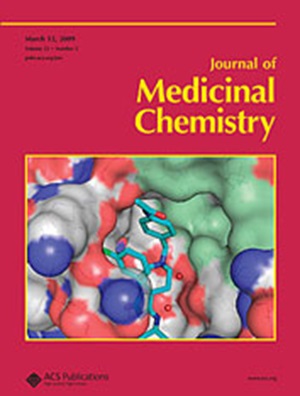IF 6.8
1区 医学
Q1 CHEMISTRY, MEDICINAL
引用次数: 0
摘要
随着新德里金属-β-内酰胺酶-1(NDM-1)、临床相关的维罗纳整合素编码金属-β-内酰胺酶(VIM)和亚胺培南酶(IMP)的出现和迅速传播,发现金属-β-内酰胺酶(MBL)抑制剂对于抗击细菌感染至关重要。这种情况令人担忧,因为没有足够的抗生素来应对严重的多重耐药感染。在此,我们报告了通过应用支架跳跃、构象约束和取代基装饰等策略,发现了新型二氢苯并吲哚(dBI)衍生物作为一类新的强效金属-β-内酰胺酶抑制剂(MBLIs)。其中,化合物 17u 对 MBL 的抑制活性最佳,其理化和 ADME 特性均可接受。17u 能显著提高碳青霉烯类对一系列产生 MBL 的临床菌株的疗效。当 17u 与亚胺培南抗生素联合使用时,这种功效扩展到体内环境,在大腿感染模型中显著减少了细菌负荷。因此,它是进一步开发 MBLI 的主要候选药物。本文章由计算机程序翻译,如有差异,请以英文原文为准。

Discovery of Conformationally Constrained Dihydro Benzo-Indole Derivatives as Metallo-β-Lactamase Inhibitors to Tackle Multidrug-Resistant Bacterial Infections
The discovery of metallo-β-lactamase (MBL) inhibitors is crucial in the fight against bacterial infections following the emergence and rapid spread of New Delhi metallo-β-lactamase-1 (NDM-1), as well as clinically relevant Verona integrin-encoded metallo-β-lactamase (VIM), and Imipenemase (IMP). The situation is alarming as there are insufficient antibiotics in the pipeline to combat critical multidrug-resistant infections. Here, we report the discovery of novel dihydrobenzo-indole (dBI) derivatives as a new class of potent metallo-β-lactamase inhibitors (MBLIs) by applying scaffold hopping, conformation constrained, and substituent-decorating strategies. Among them, compound 17u exhibited the best inhibitory activity against MBL with acceptable physicochemical and ADME properties. 17u exhibited remarkable enhancement of carbapenems’ effectiveness against a range of MBL-producing clinical strains. This efficacy extended to in vivo settings when combined with the imipenem antibiotic, significantly reducing the bacterial load in a thigh infection model. Consequently, it qualifies as a prime candidate for further development as an MBLI.
求助全文
通过发布文献求助,成功后即可免费获取论文全文。
去求助
来源期刊

Journal of Medicinal Chemistry
医学-医药化学
CiteScore
4.00
自引率
11.00%
发文量
804
审稿时长
1.9 months
期刊介绍:
The Journal of Medicinal Chemistry is a prestigious biweekly peer-reviewed publication that focuses on the multifaceted field of medicinal chemistry. Since its inception in 1959 as the Journal of Medicinal and Pharmaceutical Chemistry, it has evolved to become a cornerstone in the dissemination of research findings related to the design, synthesis, and development of therapeutic agents.
The Journal of Medicinal Chemistry is recognized for its significant impact in the scientific community, as evidenced by its 2022 impact factor of 7.3. This metric reflects the journal's influence and the importance of its content in shaping the future of drug discovery and development. The journal serves as a vital resource for chemists, pharmacologists, and other researchers interested in the molecular mechanisms of drug action and the optimization of therapeutic compounds.
 求助内容:
求助内容: 应助结果提醒方式:
应助结果提醒方式:


